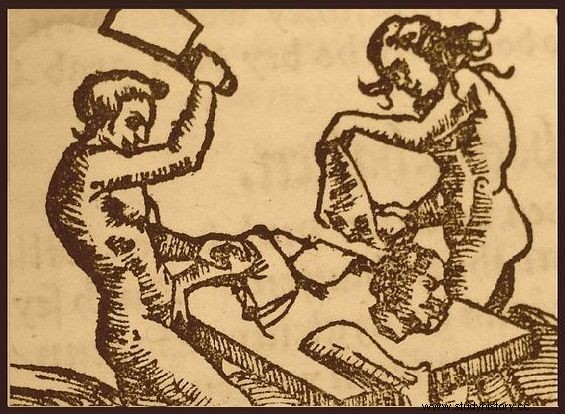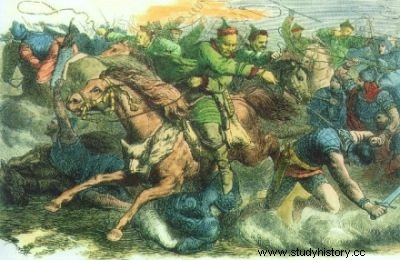Cannibalism has existed since prehistoric times. Archaeological finds confirm that our ancestors scraped with a knife, gnawed and marrowed not only animal bones ... Today, devouring a representative of our species by another Homo (apparently) sapiens causes disgust, but it was not always so.
The phenomenon of cannibalism is very deep in the human psyche and culture. We find its manifestations in myths, legends, and even in fairy tales for children. Take, for example, Kronos devouring his own children, or Tantalus, who was condemned to his torment for killing his son, making a meal from him, and trying to serve him to the gods at a feast. Even Hansel and Gretel is a story with cannibalism in the background .
Already the ancient Greeks invented a beautiful word to describe these specific culinary tastes. They coined the term "anthropophagy" ( anthropos , that is, human and fagein what it means to eat) does not sound as brutal as "cannibal" (members of the Columbus expedition distorted the name of the Caribe people, which, as it turned out, eagerly consumed humans). Scientists refer to cannibalism as the Greek term, but we will not be polite.

Jas, Małgosia and Baba Jaga who is in fact a lover of people.
Dear cannibals!
In some cultures, cannibalism was socially acceptable. It was practiced as part of magical and religious rites. In general, it can be divided into endo- and exo-cannibalism. How are they different? Well, endocannibalism consisted of eating dead relatives and friends. Imagine a situation like this: a grandfather, aunt or a family friend dies, all relatives gather, ladies cut out the best pieces of meat from the body of the deceased . Then they bake, fry and boil everything, and then serve such a meal to the assembled mourners. Everyone eats and remembers the ancestor who passed away.
Disgusting? Disgusting? For Maori or Wonkonguru Aborigines, it was a sign of the highest respect for the deceased. At the same time, it was about checking the intentions and deeds collected - whoever did not participate in the rite could be accused of contributing to the death (most often with the help of a charm).
What is a custom in a country.

Cannibals on a German engraving from the 16th century.
The so-called exo-cannibalism was a separate phenomenon. While the beliefs of primitive peoples regarding the worship of the dead by eating them with difficulty, because with difficulty, we are able to swallow, eating strangers as part of manifesting strength or practicing deity worship seems unacceptable.
Even if we assumed with Herodotus that if we asked all the nations of the world to indicate the most appropriate and worthy of customs, each of them would put their own in the first place , there are limits. On the other hand, what right do we have to be outraged? Even in our beautiful Europe, with its democracy and humanism, people were once consumed .
Sacrificial tableware
From Chinese Turkestan, through Mongolia to Champagne, about 25 bronze kettles were found. The most beautiful ones were discovered in today's Ukraine, North Caucasus, Romania, Moravia, and even in our backyard on the Vistula. These specific vessels are referred to as Asian or Scythian. They date back to the first half of the 5th century.
Near the places where they were discovered, sacrificial burials were found with valuable items - brooches, stirrups, gold ornaments, bits and weapons - of considerable value. The cauldrons show traces of soot, which, according to archaeologists, is undeniable evidence of their use in rituals.

A feast of the cannibals from the island of Tanna. Image by Charles E. Gordon Frazer.
During these rites sacrifices were made. Okay, but what? Maybe horses, sheep or cows? Not at all. After all, it is extremely difficult to imagine a handsome heifer that fastens its garments with a golden brooch and fastens a brooch between one and the other patch. The cauldrons were found not near cemeteries, but right next to the sacrificial burials, which housed the remains of Homo sapiens. People were walking under the knife.
White priestesses with red blades
What was it like in practice? Let us better give the floor to Strabo, who in his "Geography" presents a description of such a bloody sacrifice:

Another foodie man… a sculpture from the 16th century.
(...) followed by the fortune tellers who were telling the future. These white-haired, white-clad priestesses wore woolen coats fastened with safety pins and a copper belt. They walked barefoot, sword in hand, in front of the prisoners. After decorating them with wreaths, they led them to a pool, which could contain 20 amphoras, there they climbed the stairs, lifted each prisoner to the edge of the pool, cut his throat, and according to how the blood was dripping - they bode . The other priestesses opened the body and divined the entrails, announcing the victory of their army .
This interesting fragment of the work of the ancient geographer is quoted in "The Mythology of the Celts" by Jerzy Gąssowski. He states that such bloody rituals were performed by all Celts. The circle of suspects of such bloody practices, however, is narrowed down by Michel Rouche in the book "Attila and the Huns". In his opinion, Strabo described a ceremony characteristic not of all Celts, but of one of the Celto-Germanic peoples - the Cimbri. Interestingly, one of the ritual cauldrons used during human sacrifice was once given by the Cimbri Augustus.
Attention! You are not on the first page of the article. If you want to read from the beginning click here.
Blood, not water, and yet she was mixed with wine
The cauldrons and similar ritual vessels were of various sizes, reaching up to 1,200 liters of capacity and 1.6 meters in height. In the circle of Celtic influences, people sacrificed before the battle in order to predict the result. Besides fortune telling, the ritual had one more purpose.
The victim's blood was mixed with the wine in a special vessel. Then the priestess served the resulting drink to each warrior . Such a bloody feast was to drug the warriors before battle and put them into a kind of trance. It was completely different with the terrible and cruel Huns (oh this PR!).
The ritual cauldrons used by the Huns had a clear purpose. These Asian horsemen used dishes of various sizes. Pieces of human flesh were cooked in the smallest. When such a macabre dish was ready, members of the clan or family ate it together.
Such joint devouring of people was to consolidate the group and strengthen its hatred of the enemy thus humiliated to the limit. After this macabre ceremonial, somewhere outside the ritual area, the whole or broken cauldron was buried quite shallowly along with the remains of the deceased (weapons, harness, etc.). All these items were cursed and it was dangerous for the Huns to have them.

Supposedly, the scaring Huns also liked human meals.
Cannibal West?
Let's go a little further west. As it turns out, ritual cannibalism was also practiced in Gaul. In "Lex Salica", which is the common law of the Franks, collected in writing, in addition to the records of theft, murder and witchcraft, there is also paragraph against cannibalism .

A female cannibal from South America. Image by Albert Eckhout.
From this it is clear that even after the Frankish ruler Clovis had been baptized, ritual cannibals were still practiced. The code stated:
If someone accuses another person of serving witches, that is, interacting with them or bringing them a bronze cauldron in which the witches make food, and will try to prove it, but not will have sufficient evidence, will be punished .
It follows from the above that not only did there exist witches who practiced cannibalism, but there were also people who willingly helped them to carry a cauldron filled with monstrous contents. And further, to quote "Lex Salica" after Michel Rouche: If a witch eats human flesh, she will be sentenced to a tribunal for damages caused by voracity for a fine of 200 solids .
Well, you could say it's a relatively small penalty for cooking and eating your neighbor. It is not for us to judge, after all, there is no provision for cannibalism in contemporary Polish law.
Finally, let's introduce one more peculiar theory. Apparently, "barbarians" consciously and deliberately committing such a terrible act as cannibalism or fortune telling from the entrails of prisoners, deliberately built a terrible legend around them and sowed terror among their enemies.

Still from a National Geographic documentary reconstructing ... a Celtic human sacrifice.
For example, the Huns, thanks to such black PR, did not have to make a lot of effort and conquer the local population with great difficulty. The inhabitants of the land to which the horde of wild riders was approaching, at the sound of Attila's name, packed their bags and fled where pepper grows. Better than ending up in a wild Huna's belly!
’
